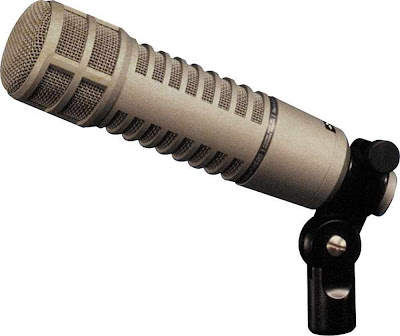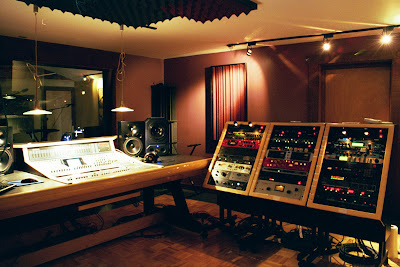Voiceovers are the mainstays of advertising, instruction and promotional videos, television programs and feature films.
You can often outsource the voice over task by hiring a professional to read your copy. This "voice" will record several versions changing word or phrase emphasis and speed, and it's just up to you as to which version to keep. However, for most small-time producers, it's common to record voiceovers in-house for budget and control reasons.

Whether you're recording yourself or professional voice talent, these tips will help you make the most of your voiceover recordings.
1 - Get the Copy Right
A great voiceover starts with a great script. Your copy needs to be clean and easy to read. Numbers under 20 should be spelled out, and others broken apart with hyphens. You may have to provide phonetic spellings for chemicals, technical terms and subjects with complicated names. Be sure to pre-read the copy before recording to verify the flow. Don't be afraid to mark the copy with notes for inflection or emphasis. It might feel funny, but it is important to read the copy out loud, using the mic and headphones. You'll get a better feel for the sound of the copy and the mic, allowing you to make any adjustments before you hit the Record button.
2 - Hydration
A vocal coach once said that proper hydration happens before the recording. While you should have a couple of bottles of water available for the voice talent, it's important to be properly hydrated ahead of the session. Drink plenty of clear liquids - preferably at room temperature. Avoid strong coffee, ice-cold soda and any drinks that contain milk products. Milk gets the mucus flowing and will dampen the performance. How about a nice cup of green tea before the session? Toss in a lemon cough drop for added insurance.
3 - Medicate Gently
I don't know about you, but as I age, my seasonal allergies get worse. Spring and Fall are very challenging, and scheduling a voiceover session can be a gamble. If you need to take medication for allergies or other ailments, go easy. Find a treatment that has a minimum effect on your system, leaving you as clear as possible, both mentally and physically. If your medicine of choice leaves you a bit groggy, take it as far ahead of the session as possible to allow your body to adapt. If all else fails, bring some tissues and cough drops for insurance.
4 - Location, Location, Location
We've talked about it before, but the space you record in is critical. A professional vocal booth is isolated from the rest of the studio, and the interior has sound-absorbent material. If you're improvising a vocal booth, drape some heavy blankets around the microphone position. Better yet, step into a walk-in closet. The hanging clothes will absorb a lot of sound reflections. If possible, choose a location as far away from traffic as possible. If you can hear the air conditioning system, turn it off during the recording.
5 - Tools of the Trade
It may seem obvious, but the voiceover talent needs to see the copy. This means you should provide decent lighting over the recording area. If you're creating an ad-hoc space, place one of your video lights overhead on a boom stand. Use a small fixture to minimize the heat. If you have some diffusion, it will help minimize shadows on the copy. Don't forget to supply a music stand or some kind of surface for the copy. Print the copy with a slightly larger font. and double-space for easy reading. Break the copy into natural sections on separate pages, so the talent won't have to shuffle papers.
6 - Mic It Up

Realistically, you can use almost any microphone for voiceover recording, but the big boys have a handful of favorites. The Electro-Voice RE-20 is the darling of talk radio, while several imported large-diaphragm condenser mics are popular in Hollywood. Consider borrowing or renting a nice microphone for your next recording. The higher quality will impress your clients, and it will be easier on your ears too. There are several models available for less than $100 today. Add one to your collection. Even at these bargain prices, you won't be disappointed.
7 - Blast It!
In addition to the microphone, you'll need a windscreen to protect against breath blasts called "plosives." Usually produced from the letters P, B and T, these vocal pops briefly overload the microphone and create distortion. Simply providing a windscreen will virtually eliminate this problem. Foam windscreens are available at your local Electronic Shack. You'll find the more professional hoop-type windscreens at your favorite online music or production retailer. You can even build one from an embroidery hoop and some pantyhose.
8 - Slate Here
Slating your voiceover recording will make it easier to edit. Since there are very few visual cues when editing audio, some simple verbal reminders will make it easier for you to navigate. Have the vocal talent preface the performance with the project, section and take number prior to recording. This doesn't have to be a rigid thing, just a verbal bookmark. Later, if you need to assemble an edit from multiple takes, it will be much easier to identify good and bad content. You can give simple visual clues by shooting the talent's (or your) hands ticking off between takes. Even if it's dark, it's better than shooting with the lens cap on, at least you can see that there is video there.
9 - Let's Try That Again
The way you hear the copy in your head may or may not be the way the client intended. That's why it's good to record multiple versions of various phrases, using different vocal inflection. Don't get carried away with this idea - just concentrate on troublesome phrases, slogans and tag lines. This gives you options after the session and can save a great deal of grief if the client had something else in mind.
10 - A Second Set of Ears
Professional voiceovers usually involve a producer to keep things on track and insure a high-quality recording. If you're not using an independent producer for your session, a second opinion may be in order. Once you've edited the voiceover, have someone listen to the project with an objective ear. Does the copy make sense? Does the structure guide the listener cleanly through the recording? Are there any words or phrases that are difficult to understand? Answers to these questions will help you step back from the project, rethink your edits and tighten the performance.
And... Cut!

Recording a voiceover doesn't have to be a huge thing - in fact, it could be one of the easiest parts of your production. These ten tips should get you started in the right direction. With a little planning and preparation, your voiceover sessions will yield killer cuts guaranteed to enhance the finished product.
You can often outsource the voice over task by hiring a professional to read your copy. This "voice" will record several versions changing word or phrase emphasis and speed, and it's just up to you as to which version to keep. However, for most small-time producers, it's common to record voiceovers in-house for budget and control reasons.

Whether you're recording yourself or professional voice talent, these tips will help you make the most of your voiceover recordings.
1 - Get the Copy Right
A great voiceover starts with a great script. Your copy needs to be clean and easy to read. Numbers under 20 should be spelled out, and others broken apart with hyphens. You may have to provide phonetic spellings for chemicals, technical terms and subjects with complicated names. Be sure to pre-read the copy before recording to verify the flow. Don't be afraid to mark the copy with notes for inflection or emphasis. It might feel funny, but it is important to read the copy out loud, using the mic and headphones. You'll get a better feel for the sound of the copy and the mic, allowing you to make any adjustments before you hit the Record button.
2 - Hydration
A vocal coach once said that proper hydration happens before the recording. While you should have a couple of bottles of water available for the voice talent, it's important to be properly hydrated ahead of the session. Drink plenty of clear liquids - preferably at room temperature. Avoid strong coffee, ice-cold soda and any drinks that contain milk products. Milk gets the mucus flowing and will dampen the performance. How about a nice cup of green tea before the session? Toss in a lemon cough drop for added insurance.
3 - Medicate Gently
I don't know about you, but as I age, my seasonal allergies get worse. Spring and Fall are very challenging, and scheduling a voiceover session can be a gamble. If you need to take medication for allergies or other ailments, go easy. Find a treatment that has a minimum effect on your system, leaving you as clear as possible, both mentally and physically. If your medicine of choice leaves you a bit groggy, take it as far ahead of the session as possible to allow your body to adapt. If all else fails, bring some tissues and cough drops for insurance.
4 - Location, Location, Location
We've talked about it before, but the space you record in is critical. A professional vocal booth is isolated from the rest of the studio, and the interior has sound-absorbent material. If you're improvising a vocal booth, drape some heavy blankets around the microphone position. Better yet, step into a walk-in closet. The hanging clothes will absorb a lot of sound reflections. If possible, choose a location as far away from traffic as possible. If you can hear the air conditioning system, turn it off during the recording.
5 - Tools of the Trade
It may seem obvious, but the voiceover talent needs to see the copy. This means you should provide decent lighting over the recording area. If you're creating an ad-hoc space, place one of your video lights overhead on a boom stand. Use a small fixture to minimize the heat. If you have some diffusion, it will help minimize shadows on the copy. Don't forget to supply a music stand or some kind of surface for the copy. Print the copy with a slightly larger font. and double-space for easy reading. Break the copy into natural sections on separate pages, so the talent won't have to shuffle papers.
6 - Mic It Up

Realistically, you can use almost any microphone for voiceover recording, but the big boys have a handful of favorites. The Electro-Voice RE-20 is the darling of talk radio, while several imported large-diaphragm condenser mics are popular in Hollywood. Consider borrowing or renting a nice microphone for your next recording. The higher quality will impress your clients, and it will be easier on your ears too. There are several models available for less than $100 today. Add one to your collection. Even at these bargain prices, you won't be disappointed.
7 - Blast It!
In addition to the microphone, you'll need a windscreen to protect against breath blasts called "plosives." Usually produced from the letters P, B and T, these vocal pops briefly overload the microphone and create distortion. Simply providing a windscreen will virtually eliminate this problem. Foam windscreens are available at your local Electronic Shack. You'll find the more professional hoop-type windscreens at your favorite online music or production retailer. You can even build one from an embroidery hoop and some pantyhose.
8 - Slate Here
Slating your voiceover recording will make it easier to edit. Since there are very few visual cues when editing audio, some simple verbal reminders will make it easier for you to navigate. Have the vocal talent preface the performance with the project, section and take number prior to recording. This doesn't have to be a rigid thing, just a verbal bookmark. Later, if you need to assemble an edit from multiple takes, it will be much easier to identify good and bad content. You can give simple visual clues by shooting the talent's (or your) hands ticking off between takes. Even if it's dark, it's better than shooting with the lens cap on, at least you can see that there is video there.
9 - Let's Try That Again
The way you hear the copy in your head may or may not be the way the client intended. That's why it's good to record multiple versions of various phrases, using different vocal inflection. Don't get carried away with this idea - just concentrate on troublesome phrases, slogans and tag lines. This gives you options after the session and can save a great deal of grief if the client had something else in mind.
10 - A Second Set of Ears
Professional voiceovers usually involve a producer to keep things on track and insure a high-quality recording. If you're not using an independent producer for your session, a second opinion may be in order. Once you've edited the voiceover, have someone listen to the project with an objective ear. Does the copy make sense? Does the structure guide the listener cleanly through the recording? Are there any words or phrases that are difficult to understand? Answers to these questions will help you step back from the project, rethink your edits and tighten the performance.
And... Cut!

Recording a voiceover doesn't have to be a huge thing - in fact, it could be one of the easiest parts of your production. These ten tips should get you started in the right direction. With a little planning and preparation, your voiceover sessions will yield killer cuts guaranteed to enhance the finished product.
Source



0 Comments:
Post a Comment
<< Home